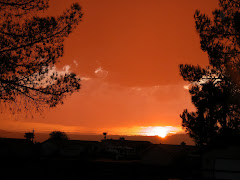 For me and Mom most Memorial Day's have meant a visit to Fort Logan National Cemetery on or sometime during this weekend we go to place flowers on my Dad's grave. Over the last 41 years I've many memories of trips there with Mom and with Grandma & Grandpa, Tom or Nancy when they've come in town for a visit. I guess my age is beginning to show now because the trees I always picture in my mind's eye are much smaller than what they actually are these days and I'm amazed at how much further the rows of white headstones stretch every year.
For me and Mom most Memorial Day's have meant a visit to Fort Logan National Cemetery on or sometime during this weekend we go to place flowers on my Dad's grave. Over the last 41 years I've many memories of trips there with Mom and with Grandma & Grandpa, Tom or Nancy when they've come in town for a visit. I guess my age is beginning to show now because the trees I always picture in my mind's eye are much smaller than what they actually are these days and I'm amazed at how much further the rows of white headstones stretch every year.While reading online about the origins of Memorial Day I realized that Fort Logan was named after General John A. Logan, a Civil War era general, who is responsible for what has come to be called the Memorial Day Order:
I. The 30th day of May, 1868, is designated for the purpose of strewing with flowers, or otherwise decorating the graves of comrades who died in defense of their country during the late rebellion, and whose bodies now lie in almost every city, village and hamlet churchyard in the land. In this observance no form or ceremony is prescribed, but Posts and comrades will, in their own way arrange such fitting services and testimonials of respect as circumstances may permit.
We are organized, Comrades, as our regulations tell us, for the purpose among other things, "of preserving and strengthening those kind and fraternal feelings which have bound together the soldiers sailors and Marines, who united to suppress the late rebellion." What can aid more to assure this result than by cherishing tenderly the memory of our heroic dead? We should guard their graves with sacred vigilance. All that the consecrated wealth and taste of the nation can add to their adornment and security, is but a fitting tribute to the memory of her slain defenders. Let pleasant paths invite the coming and going of reverent visitors and fond mourners. Let no neglect, no ravages of time, testify to the present or to the coming generations that we have forgotten as a people the cost of a free and undivided republic.
If other eyes grow dull and other hinds slack, and other hearts cold in the solemn trust, ours shall keep it well as long as the light and warmth of life remain in us.
Let us, then, at the time appointed, gather around their sacred remains, and garland the passionless mounds above them with choicest flowers of springtime; let us raise above them the dear old flag they saved; let us in this solemn presence renew our pledge to aid and assist those whom they have left among us a sacred charge upon the Nation's gratitude—the soldier's and sailor's widow and orphan.
II. It is the purpose of the Commander in Chief to inaugurate this observance with the hope that it will be kept up from year to year, while a survivor of the war remains to honor the memory of his departed comrades. He earnestly desires the public press to call attention to this Order, and lend its friendly aid in bringing it to the notice of comrades in all parts of the country in time for simultaneous compliance therewith.
III. Department commanders will use every effort to make this Order effective.
By order of
JOHN A. LOGAN,
Commander-in-Chief
N.P. CHIPMAN,
Adjutant General
Official:
WM. T. COLLINS,
A.A.G.

Originally this day was known as "Decoration Day" and as the order states it was first enacted to honor Union soldiers after the Civil War but was later expanded to include American casualties of any war or military action after World War I.
The alternative name of "Memorial Day" was first used in 1882. It did not become more common until after World War II, and was not declared the official name by Federal law until 1967. In 1968, Congress passed the Uniform Holidays Bill, which moved three holidays from their traditional dates to a specified Monday in order to create a convenient three-day weekend. This change moved Memorial Day from its traditional May 30th date to the last Monday in May.







No comments:
Post a Comment